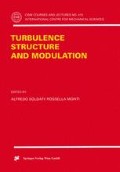Abstract
Electromagnetic Turbulence Control (EMTC) provides an innovative control technique for restructuring the boundary layer of a conducting fluid and, thereby, reducing viscous drag. The advantage of this approach over classical control methods is that it introduces a body force that can affect a large portion of the boundary layer. This electromagnetic force varies both temporally and spatially in a complex manner, allowing for a multitude of control possibilities. This paper investigates the capabilities of numerical simulations in computing these flows and examines the predicted flow physics to gain additional insight into the control mechanism. Simulations are reported for both isolated actuators and arrays of tiles. Many of the flow features and sensitivities detected experimentally are present in the computational results, but significant drag reduction is not obtained.
The authors wish to acknowledge funding of this work by DARPA, NUWC, and the Boeing Company, as well as the close collaboration of Prof. D. Nosenchuck(Princeton University), K. Perko(Nova Innovations), R. Phillips(NUWC), and G. Karniadakis(Brown University)
Access this chapter
Tax calculation will be finalised at checkout
Purchases are for personal use only
Preview
Unable to display preview. Download preview PDF.
References
Bushnell, D. M. (1990). Viscous Drag Reduction in Boundary Layers. American Institute of Aeronautics and Astronautics, Inc.
Cary, A. W., Donovan, J. F., and Kral, L. D. (1999). Flow structure development over an electromagnetic turbulence control (emtc) actuator. In Proceedings of the 3rd ASME/JSME Joint Fluids Engineering Conference.
Culver, H. C. M. (1996). An experimental investigation of a laminar boundary layer subject to an applied Lorentz force. Master’s thesis, Princeton University, Princeton, NJ.
Donovan, J. F., and Kral, L. D. (1994). Numerical investigation of turbulence control using electromagnetic forces. In 47th Annual Meeting of the Division of Fluid Dynamics, American Physical Society.
Donovan, J. F., Kral, L. D., and Cary, A. W. (1997). Characterization of a Lorentz force actuator. AIAA 97–1918.
Du, Y., Karniadakis, G. E., and Beskok, A. (1999). Simulation of a Lorentz force actuator. In Proceedings of the 3rd ASME/JSME Joint Fluids Engineering Conference.
Hatay, F F., O’Sullivan, P. L., Biringen, P. L., and Bandyopadhyay, P. R. (1997). Numerical simulation of secondary flows in channels driven by applied Lorentz forces. AIM Journal of Thermophysics and Heat Transfer 11(446).
Jones, W. P., and Launder, B. (1973). The calculation of low-Reynolds-number phenomena with a twoequation model of turbulence. International Journal of Heat and Mass Transfer 16: 1119–1130.
Karniadakis, G., and Du, Y. (1999). Direct numerical simulation of EMTC. Private Communication.
Kral, L. D., and Donovan, J. F. (1996). Numerical simulation of turbulence control using electromagnetic forces. In Parekh, D. E., and Agarwal, R. K., eds., Proc. of the Forum on Control of Transitional and Turbulent Flows, number FED-237. ASME Fluids Engineering Conference.
Kral, L. D., Mani, M., and Ladd, J. (1997a). Application of turbulence models for aerodynamic and propulsion flowfields. AIM Journal 34 (11): 2291–2298.
Kral, L. D., Donovan, J. F, and Cary, A. W. (1997b). Numerical simulation and analysis of flow control using electromagnetic forcing. AIAA 97–1797.
Kral, L. D. (1998). Recent experience with different turbulence models applied to the calculation of flow over aircraft components. Progress in Aerospace Sciences 34: 481–541.
Menter, F. R. (1993). Zonal two equation k–w turbulence models for aerodynamic flows. AIAA 93–2906.
Nosenchuck, D. M., and Brown, G. L. (1992). The direct control of wall shear stress in a turbulent boundary layer. MAE Report T1954, Princeton University, Princeton, NJ.
Nosenchuck, D. M., Brown, G. L., Culver, H. C., Eng, T. I., and Huang, I. S. (1995). Spatial and temporal characteristics of boundary layers controlled with the Lorentz force. In Twelfth Australasian Fluid Mechanics Conference. Extended Abstract.
Nosenchuck, D. M. (1996). Boundary layer control using the Lorentz force. In Parekh, D. E., and Agarwal, R. K., eds., Proc. of the Forum on Control of Transitional and Turbulent Flows, number FED-237. ASME Fluids Engineering Conference.
Phillips, R. (1998). Results from experiments on the isolated NUWC EMTC tile. Private Communication.
Rogers, S. E., and Kwak, D. (1990). An upwind differencing scheme for the time-accurate incompressible Navier-Stokes equations. AIM Journal 28 (2): 253–262.
Rogers, S. E., Kwak, D., and Kiris, C. (1991). Steady and unsteady solutions of the incompressible NavierStokes equations. AIM Journal 29 (4): 603–610.
Spalart, P. R., and Allmaras, S. R. (1992). A one-equation turbulence model for aerodynamic flows. AIAA 92–0439.
Subramanian, N. (1999). Investigation of flow patterns involving a single tile Lorentz force actuator. Master’s thesis, Washington University, St. Louis, Missouri.
Sujudi, D., and Haimes, R. (1995). Identification of swirling flow in 3-D vector fields. AIAA 95–1715-CP.
Author information
Authors and Affiliations
Editor information
Editors and Affiliations
Rights and permissions
Copyright information
© 2001 Springer-Verlag Wien
About this chapter
Cite this chapter
Cary, A.W., Donovan, J.F., Kral, L.D. (2001). Overview of Numerical Simulations of Electromagnetic Turbulence Control (EMTC). In: Soldati, A., Monti, R. (eds) Turbulence Structure and Modulation. International Centre for Mechanical Sciences, vol 415. Springer, Vienna. https://doi.org/10.1007/978-3-7091-2574-8_7
Download citation
DOI: https://doi.org/10.1007/978-3-7091-2574-8_7
Publisher Name: Springer, Vienna
Print ISBN: 978-3-211-83339-1
Online ISBN: 978-3-7091-2574-8
eBook Packages: Springer Book Archive

